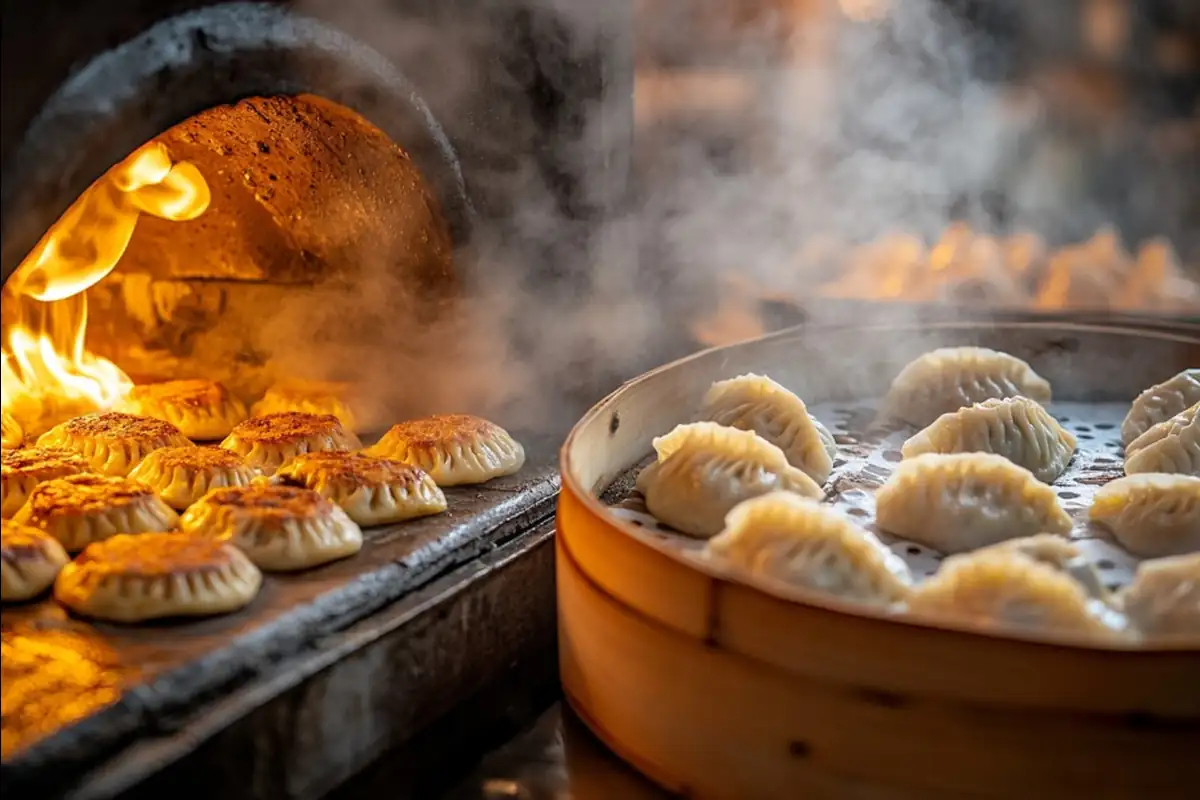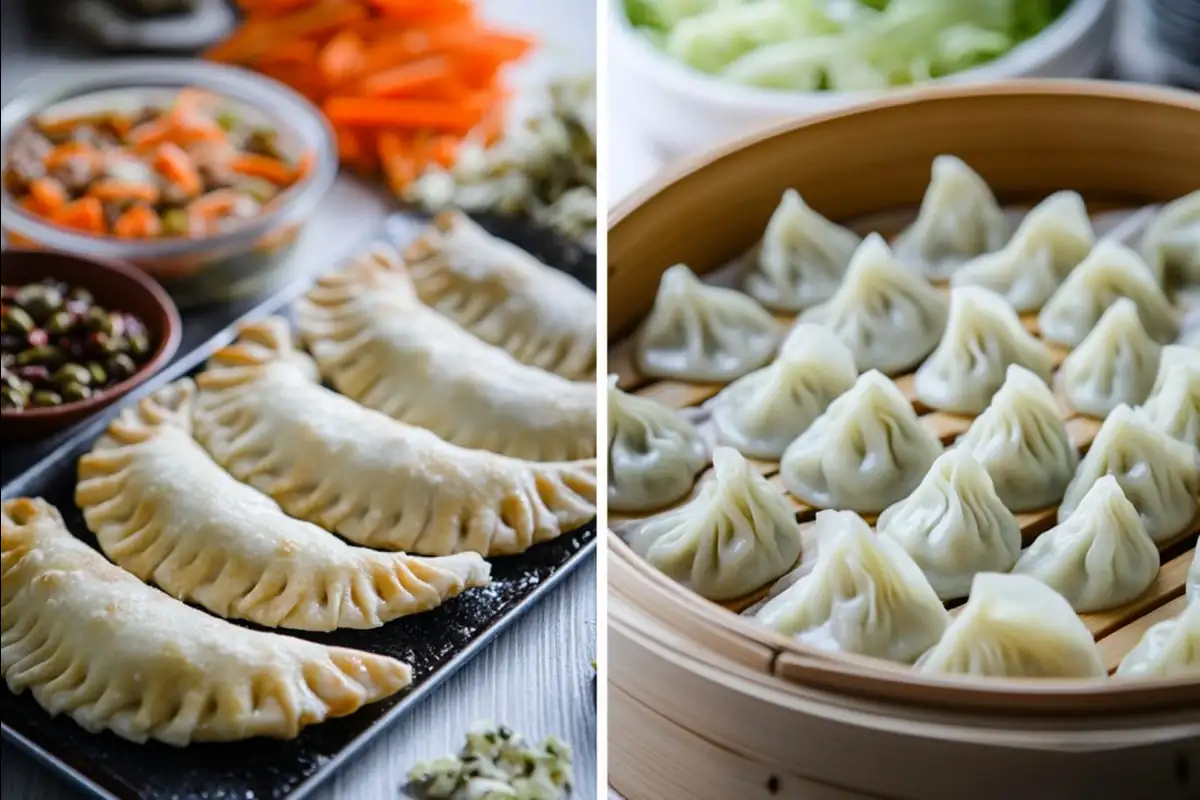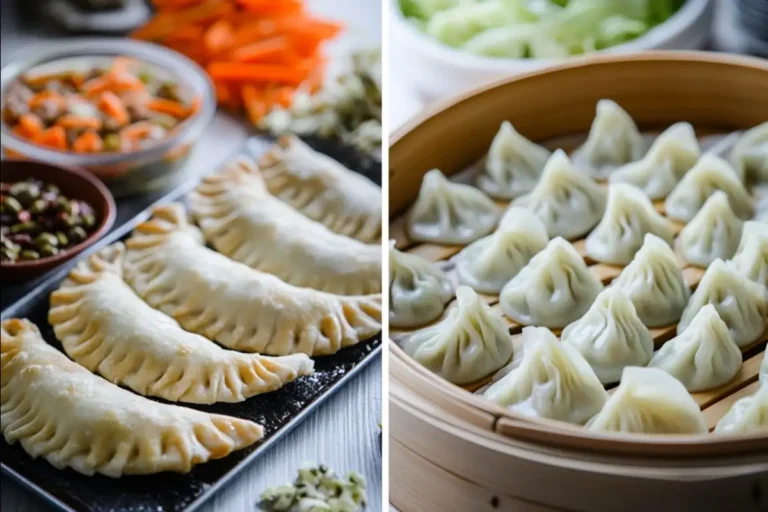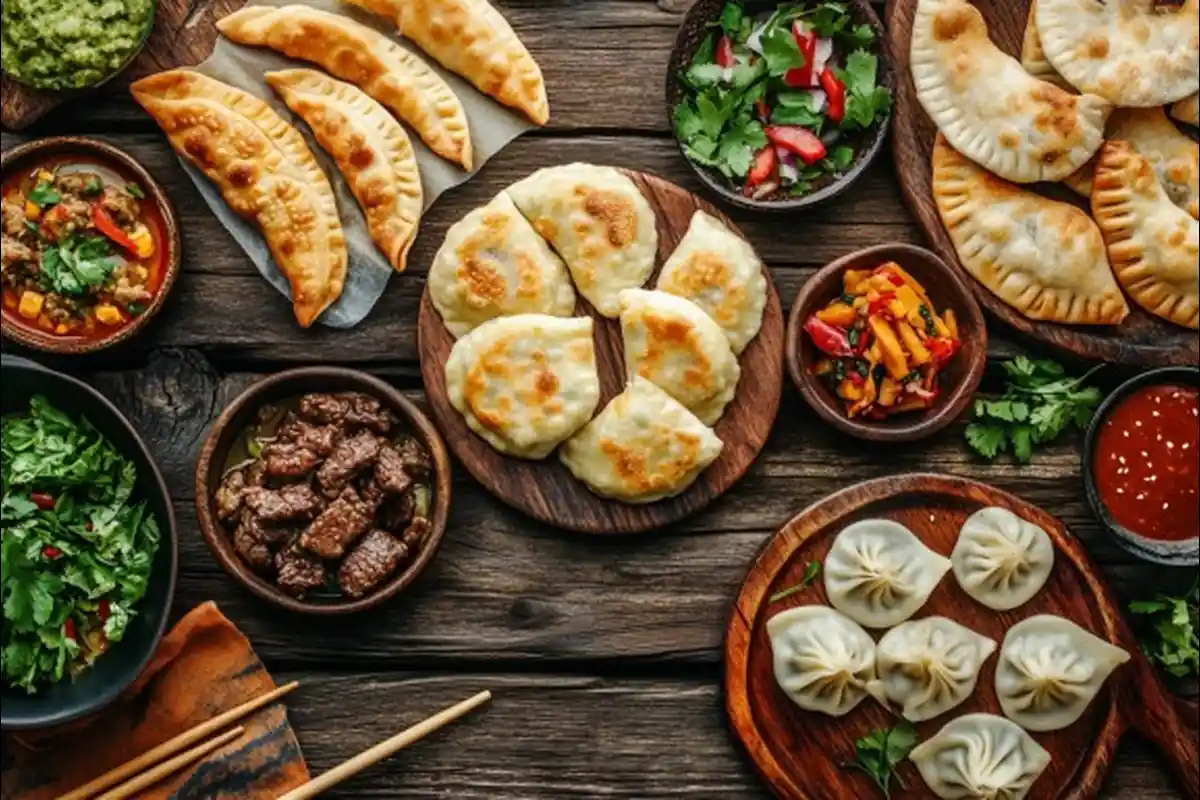1: Introduction
Empanadas and dumplings are culinary treasures that transcend borders, offering a glimpse into the heart of diverse cultures. But what’s the difference between empanadas and dumplings? At first glance, they might seem similar—portable pockets filled with savory or sweet delights. However, their preparation, cultural roots, and even the doughs used to create them tell unique stories.
Empanadas, with their crispy golden crusts, are iconic in Latin America, Spain, and the Philippines, representing family gatherings and festive occasions. Dumplings, on the other hand, boast global acclaim, ranging from Chinese xiao long bao to Polish pierogi, each reflecting the traditions of its region.
Understanding the differences is more than a culinary curiosity—it’s a celebration of food as a shared language. In this article, we’ll dive deep into their histories, cooking methods, flavor profiles, and even their health implications. By the end, you’ll see how these seemingly simple dishes hold profound cultural significance.
2: What Are Empanadas and Dumplings?
What Are Empanadas?
Empanadas are half-moon-shaped pastries that combine flaky dough with a wide variety of fillings. The name comes from the Spanish word empanar, meaning “to coat in bread.” This reflects the dish’s origins as a portable, bread-based meal for workers and travelers. Empanadas are prepared by wrapping dough around ingredients like seasoned meats, vegetables, cheese, or even sweet fillings such as guava and caramel.
The dough can vary based on the region and preparation style. In Latin American countries like Argentina, empanadas are commonly made with wheat flour dough and baked to golden perfection. In contrast, Filipino empanadas often feature a slightly sweeter dough, influenced by the country’s Spanish colonial history. Fried empanadas are also popular in regions like the Caribbean, where the crispy texture pairs well with spiced fillings.
Empanadas aren’t just food; they’re a cultural symbol. They are staples of festivals, family gatherings, and street food markets. For instance, Argentina’s empanadas de carne (meat empanadas) are an essential part of Independence Day celebrations.
What Are Dumplings?
Dumplings are small pieces of dough filled with an array of ingredients, often steamed, boiled, or fried. Unlike empanadas, the dough is usually thinner and more elastic, often made from wheat or rice flour. Dumplings are incredibly versatile and can range from bite-sized Chinese wontons to large, hearty European pierogi.
In Asia, dumplings like xiao long bao (soup dumplings) are a culinary art form, with delicate folds enclosing a savory broth. In Europe, pierogi and ravioli showcase how different cultures adapt the dumpling concept using local ingredients and flavors. Dumplings can be savory, like Japanese gyoza filled with pork and vegetables, or sweet, like Czech fruit dumplings coated in sugar.
Like empanadas, dumplings are deeply tied to cultural traditions. For example, Chinese dumplings (jiaozi) are a key part of Lunar New Year celebrations, symbolizing wealth and prosperity.
Understanding the Key Differences Between Empanadas and Dumplings
Empanadas and dumplings share several traits that make them universally loved:
- Portability: Both are easy to carry, making them popular street foods.
- Filling Variety: Both offer savory and sweet options, showcasing the creativity of cooks worldwide.
- Cultural Significance: Both dishes are associated with celebrations and bring families together through shared meals.
How Empanadas and Dumplings Differ in Ingredients and Texture
Despite their similarities, the differences between empanadas and dumplings are striking:
- Dough Texture: Empanadas use pastry-like dough that’s firmer and often flaky, while dumplings use softer, more elastic dough.
- Cooking Techniques: Empanadas are typically baked or fried, whereas dumplings are steamed, boiled, or pan-fried.
- Shape and Size: Empanadas are crescent-shaped and larger, while dumplings are smaller and come in diverse shapes, from half-moons to round parcels.
3: Cultural Significance of Empanadas and Dumplings
Empanadas as a Latin American Icon
The history of empanadas traces back to Spain, where they were influenced by the Moors during the 8th century. The concept of wrapping dough around fillings was derived from samosas, brought to Spain by Arab traders. Over time, empanadas evolved into their distinct form, becoming a centerpiece of Spanish cuisine.
When Spanish colonizers traveled to Latin America, they brought empanadas with them. Each region adapted the dish based on local ingredients and cooking methods. In Argentina, empanadas became synonymous with hearty, meat-filled meals, while in the Philippines, Spanish influence gave rise to sweet and savory variations.
Today, empanadas continue to symbolize comfort and tradition. They are enjoyed as everyday meals, celebratory dishes, and even street food staples.
Dumplings in Asian and European Traditions
Dumplings boast an equally rich history, with their origins rooted in ancient China. Legend has it that dumplings were invented by Zhang Zhongjing, a Chinese physician, during the Han Dynasty (206 BCE–220 CE). He created dumplings filled with meat and herbs to help villagers combat frostbite during harsh winters. This early innovation highlights a key aspect of the dumpling vs empanada debate—while dumplings were designed as warming, medicinal food, empanadas evolved as portable meals for travelers and workers.
From China, the concept of dumplings spread across Asia and Europe via trade routes. In Europe, dumplings adapted to local ingredients, resulting in dishes like Polish pierogi and Italian ravioli. In Asia, countries like Japan, Korea, and Vietnam developed their own variations, such as gyoza, mandu, and bánh bao.
Dumplings are often tied to festive traditions. In Chinese culture, dumplings represent wealth, with their shape resembling gold ingots. Meanwhile, European dumplings like knödel are enjoyed during holiday feasts and family gatherings.
Cultural Significance
Both empanadas and dumplings are more than just food—they’re symbols of cultural identity and resilience. They represent resourcefulness, as both dishes were initially created to stretch limited ingredients into filling meals. Their ties to holidays and celebrations further highlight their importance in bringing people together.
Whether served during Argentina’s Independence Day or China’s Lunar New Year, these dishes connect generations and celebrate cultural heritage.
4: Empanadas vs Dumplings: A Culinary Comparison
Cooking Methods: Baking, Frying, Steaming, and Boiling

Empanadas:
Empanadas are primarily cooked through two methods: baking and frying.
- Baking: This method remains popular in countries like Argentina and Chile, where bakers bake empanadas to a golden brown, creating a crispy yet flaky crust. Many people consider baking the healthier option, especially for larger empanadas filled with meat, vegetables, or cheese.
- Frying: Common in the Caribbean and parts of South America, frying gives empanadas a crunchy exterior and a rich flavor. Fried empanadas are especially popular as street food, offering quick, satisfying meals for people on the go.
Dumplings:
Dumplings are celebrated for their versatility in cooking techniques. Some of the most common methods include:
- Steaming: This is the preferred method for many Asian dumplings, such as Chinese xiao long bao and Japanese shumai. Steaming preserves the delicate texture of the dumpling wrapper while ensuring the fillings stay juicy.
- Boiling: In Europe, cooks boil dumplings like pierogi and matzo balls, creating a soft, pillowy texture that pairs well with soups and sauces.
- Frying: Dumplings such as gyoza achieve a crispy bottom and retain a tender upper layer when you pan-fry them.
Taste and Texture: Crispy Empanadas vs Chewy Dumplings
Empanadas:
Empanadas deliver bold and hearty flavors. The pastry shell provides a rich, buttery base that complements the fillings.
- Savory empanadas typically feature spiced ground beef, shredded chicken, or cheese mixed with onions, olives, and boiled eggs.
- Sweet versions, like those from the Philippines, feature fillings such as sweetened plantains, custard, or guava paste, offering a dessert-like twist.
Dumplings:
Dumplings offer a wide range of flavor profiles depending on the region and cooking style.
- Asian dumplings like jiaozi or wontons have delicate, flavorful fillings often made with pork, shrimp, garlic, and ginger. Soy sauce or vinegar-based dips enhance their taste.
- European dumplings lean toward heartier flavors, with fillings like sauerkraut, mushrooms, or potatoes, paired with rich sauces or sour cream.
Modern Adaptations
In today’s globalized culinary scene, chefs are reimagining empanadas and dumplings with modern twists:
- Fusion Empanadas: Chefs are experimenting with unique fillings like barbecue pulled pork, curried lentils, and even dessert options like Nutella with marshmallows.
- Creative Dumplings: Dumplings are also evolving, featuring fillings like truffle-infused mushrooms or vegan alternatives using jackfruit or tofu. In fusion cuisine, you might find dumplings paired with Western flavors like cheddar cheese or buffalo sauce.
These innovations show how versatile both dishes are, blending tradition with modern tastes to appeal to a wider audience.
5: Health and Nutrition
Calories and Nutritional Value
Empanadas:
The calorie content of empanadas depends on the cooking method and the type of fillings.
- Baked empanadas are generally lower in calories compared to their fried counterparts. A medium-sized baked empanada filled with chicken or vegetables may contain around 200–300 calories.
- Fried empanadas have a higher calorie count due to the oil used in the preparation, often ranging between 300–500 calories per serving.
Nutritionally, empanadas are rich in carbohydrates from the dough and protein from fillings like meat or cheese. However, fried versions may also contain higher amounts of fats and cholesterol.
Dumplings:
It offer a lighter nutritional profile, particularly when steamed or boiled.
- A serving of steamed dumplings, such as jiaozi or wontons, typically contains around 40–60 calories per piece, depending on the filling.
- Pan-fried or deep-fried dumplings, like gyoza, often double in calorie content, with each piece ranging between 80–120 calories.
Dumplings are often lower in fat than fried empanadas, especially when paired with vegetable-based fillings. Their smaller size also makes portion control easier for those monitoring calorie intake.
Dietary Preferences and Options
Empanadas:
Modern empanada recipes cater to various dietary needs. For instance:
- Gluten-Free Options: Substituting traditional wheat flour with gluten-free alternatives like rice flour or almond flour makes empanadas suitable for gluten-intolerant individuals.
- Low-Fat Alternatives: Baking instead of frying significantly reduces fat content, and using lean proteins or plant-based fillings further enhances their nutritional profile.
Dumplings:
Dumplings are similarly adaptable to different dietary preferences:
- Vegan Dumplings: Popular fillings include tofu, mushrooms, and vegetables, creating a completely plant-based option.
- Gluten-Free Dumplings: Rice paper wrappers or dough made from tapioca starch offer alternatives for those avoiding gluten.
- Low-Carb Choices: Some dumplings forego dough altogether, using cabbage leaves as wrappers for a low-carb version.
Health Impact of Cooking Methods
The cooking method plays a significant role in the healthiness of empanadas and dumplings:
- Steamed Dumplings retain nutrients and require no added fats, making them a heart-healthy choice.
- Baked Empanadas offer similar health benefits, avoiding the calories and fats associated with frying.
- Fried Versions of both dishes can be enjoyed occasionally but should be moderated due to higher fat and calorie content.
When paired with nutrient-dense sides like salads or soups, both empanadas and dumplings can be part of a balanced diet.
6: Step-by-Step Recipes: Dumpling or Empanada, Which Should You Try First?

Homemade Empanadas: Easy Recipe for BeginnersrsY Empanada Recipe
Empanadas are versatile, and making them at home can be a fun and rewarding experience. Here’s a simple recipe to try:
Ingredients for Empanada Dough
- 2 ½ cups all-purpose flour
- ½ cup unsalted butter, chilled and diced
- 1 teaspoon salt
- 1 large egg
- ⅓ cup cold water
Ingredients for Filling (Classic Beef)
- 1 tablespoon olive oil
- 1 medium onion, finely chopped
- 1 garlic clove, minced
- ½ pound ground beef
- ¼ cup green olives, chopped
- 2 hard-boiled eggs, diced
- 1 teaspoon smoked paprika
- Salt and pepper to taste
Instructions
- Prepare the Dough:
- In a large bowl, mix the flour and salt. Add the butter and work it into the flour using your fingers or a pastry cutter until it resembles breadcrumbs.
- Beat the egg with water and gradually mix it into the dough until it forms a ball. Wrap in plastic and refrigerate for 30 minutes.
- Make the Filling:
- Heat the olive oil in a pan. Sauté the onion and garlic until soft.
- Add the ground beef, breaking it up with a spoon. Cook until browned.
- Stir in olives, eggs, paprika, salt, and pepper. Allow the filling to cool.
- Assemble the Empanadas:
- Roll out the dough to 1/8-inch thickness and cut into circles (4–5 inches in diameter).
- Place a spoonful of filling in the center of each circle. Fold the dough over to form a half-moon shape, sealing the edges with a fork.
- Cook the Empanadas:
- For baking: Preheat the oven to 375°F (190°C). Place empanadas on a baking sheet, brush with beaten egg, and bake for 20–25 minutes until golden brown.
- For frying: Heat oil in a skillet to 350°F (175°C). Fry the empanadas in batches until crisp and golden, about 2–3 minutes per side.
Making Perfect Dumplings at Home
Making dumplings at home is equally enjoyable and offers endless customization options. Here’s a basic recipe for steamed dumplings:
Ingredients for Dumpling Dough
- 2 cups all-purpose flour
- ¾ cup hot water
- Pinch of salt
Ingredients for Filling (Pork and Vegetable)
- ½ pound ground pork
- 1 cup finely chopped cabbage
- 2 green onions, minced
- 1 tablespoon soy sauce
- 1 teaspoon sesame oil
- ½ teaspoon grated ginger
- Salt and pepper to taste
Instructions
- Prepare the Dough:
- In a large bowl, mix the flour and salt. Gradually add hot water while stirring with chopsticks or a spoon.
- Knead the dough for 8–10 minutes until smooth. Cover with a damp cloth and let it rest for 30 minutes.
- Make the Filling:
- In a bowl, mix the pork, cabbage, green onions, soy sauce, sesame oil, ginger, salt, and pepper until well combined.
- Shape the Dumplings:
- Roll the dough into a thin log and cut into small pieces. Roll each piece into a 3-inch circle.
- Place a teaspoon of filling in the center. Fold the dough over and pleat the edges to seal, forming a half-moon shape.
- Cook the Dumplings:
- For steaming: Arrange dumplings on a parchment-lined steamer tray, leaving space between each. Steam over boiling water for 8–10 minutes.
- For frying: Heat oil in a skillet. Fry dumplings until the bottom is golden, then add a splash of water and cover to steam for 5–7 minutes.
Comparison Table: Empanadas vs. Dumplings
| Feature | Empanadas | Dumplings |
|---|---|---|
| Dough | Pastry-like, flaky | Thin, elastic |
| Cooking Methods | Baked or fried | Steamed, boiled, fried |
| Popular Fillings | Beef, chicken, cheese, sweet fruit | Pork, shrimp, vegetables, tofu |
| Regional Variations | Argentine, Filipino, Spanish | Chinese, Japanese, Polish |
| Texture | Crispy or flaky | Soft, chewy, or crispy-bottomed |
7: FAQs
What are dumplings actually called?
Dumplings go by different names across the globe, reflecting their regional adaptations. In China, people call them jiaozi or xiao long bao (soup dumplings). In Japan, they refer to them as gyoza, while in Korea, they call them mandu. European variations include Polish pierogi and Italian ravioli, which often spark a delightful dumpling or empanada comparison among food enthusiasts. These diverse names highlight the universal appeal and versatility of dumplings in various cuisines.
What is the American version of dumplings?
In the United States, dumplings often refer to doughy pieces cooked in soups or stews. A classic example is “chicken and dumplings,” where soft dough balls simmer in a flavorful broth. Another American favorite features fried or baked apple dumplings, a sweet treat with apples wrapped in pastry dough. While these versions differ from Asian or European dumplings, they share the comforting appeal of the dish.
Are empanadas and dumplings the same?
No, empanadas and dumplings are not the same, though they share similarities. What’s the difference between empanadas and dumplings? The answer lies in their dough, cooking techniques, and overall textures. Empanadas use a pastry-like dough and are typically baked or fried, while dumplings are made with a thinner, more elastic dough and are steamed, boiled, or fried. The fillings, textures, and cooking methods set them apart, reflecting their unique cultural origins and culinary styles.
What makes something an empanada?
An empanada is defined by its crescent shape, flaky or crispy pastry, and its versatility in fillings. The word empanada comes from the Spanish verb empanar, meaning “to wrap in bread,” which captures the essence of the dish. Whether savory or sweet, baked or fried, an empanada must consist of a dough wrapper filled with flavorful ingredients, sealed to preserve the delicious contents.
8: Conclusion
Empanadas and dumplings are more than just food—they’re cultural icons that tell the stories of their origins and the creativity of the people who make them. While both are dough-filled delights with savory and sweet variations, their differences lie in their preparation, flavors, and cultural contexts. Empanadas boast crispy, flaky pastry and are usually baked or fried, while dumplings feature soft, elastic dough and are often steamed, boiled, or pan-fried.
Understanding what’s the difference between empanadas and dumplings deepens our appreciation for these beloved dishes. Whether it’s the hearty warmth of a baked empanada or the delicate bite of a steamed dumpling, both reflect the diverse culinary traditions of the world. By celebrating their uniqueness and savoring their flavors, we connect with the rich histories and traditions they represent.
So, the next time you enjoy an empanada or a dumpling, remember that you’re tasting a piece of history wrapped in dough—a testament to the creativity and resilience of global cuisines.
Print
What’s the difference between empanadas and dumplings?
Empanadas and dumplings are both delicious, filled pastries enjoyed worldwide, but they have key differences. Empanadas, popular in Latin America and Spain, feature a flaky or doughy crust filled with meats, cheese, or vegetables, then baked or fried. Dumplings, found in Asian cuisine, have a soft or chewy wrapper made from wheat or rice flour, often steamed, boiled, or pan-fried. This recipe will guide you in making traditional beef empanadas, highlighting their crispy, golden-brown crust and savory filling.
- Total Time: 1 hour 5 minutes
- Yield: 12 empanadas
Ingredients
Beef Empanadas Recipe
Ingredients:
For the Dough:
- 2 ½ cups all-purpose flour
- ½ teaspoon salt
- ½ cup unsalted butter, cold and diced
- 1 large egg
- ⅓ cup cold water
- 1 tablespoon white vinegar
For the Filling:
- 1 tablespoon olive oil
- ½ pound ground beef
- 1 small onion, finely chopped
- 2 cloves garlic, minced
- ½ teaspoon ground cumin
- ½ teaspoon smoked paprika
- ¼ teaspoon chili powder
- Salt and pepper to taste
- ¼ cup green olives, chopped
- ¼ cup hard-boiled eggs, chopped (optional)
- 1 tablespoon tomato paste
For Assembly:
- 1 egg (for egg wash)
Instructions
Prepare the Dough:
- In a large bowl, whisk flour and salt.
- Cut in butter using a pastry cutter or your hands until the mixture resembles coarse crumbs.
- In a small bowl, whisk the egg, water, and vinegar; add to the flour mixture.
- Mix until dough forms, then knead lightly. Wrap in plastic and refrigerate for 30 minutes.
Make the Filling:
- Heat olive oil in a skillet over medium heat. Add onion and garlic, sauté until soft.
- Add ground beef, breaking it up while cooking. Stir in cumin, paprika, chili powder, salt, and pepper.
- Once beef is browned, add tomato paste, olives, and eggs. Stir to combine, then let it cool.
Assemble the Empanadas:
- Roll out the dough to about ⅛-inch thick and cut into 4- to 5-inch circles.
- Place a spoonful of filling in the center of each circle. Fold over and seal edges using a fork.
Bake or Fry:
- For Baking: Preheat oven to 375°F (190°C). Brush empanadas with egg wash and bake for 20-25 minutes until golden.
- For Frying: Heat oil to 350°F (175°C) and fry empanadas until golden brown, about 2-3 minutes per side.
Serve:
- Let cool slightly before serving. Enjoy with chimichurri or salsa!
Notes
- For a spicier kick, add a pinch of cayenne pepper to the filling.
- You can substitute beef with chicken, cheese, or vegetables for variety.
- Store leftover empanadas in an airtight container and reheat in the oven.
- Prep Time: 40 minutes
- Cook Time: 25 minutes
- Category: Appetizer, Snack
- Method: Baking, Frying
- Cuisine: Latin American, Spanish


1 thought on “What’s the difference between empanadas and dumplings?”